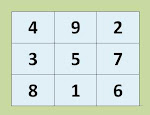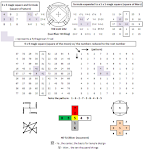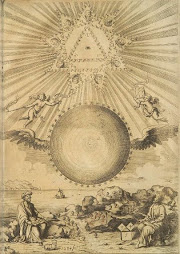THE 13X13 MAGIC SQUARE
If numbers are in fact a language, then the most important feature for numbers is to provide functional information about Time and Space. Magic squares in the Luo Shu format do exactly this.THE NUMBER 13
The most important thing about the number 13 is that it is the seventh odd number.
The second most important thing about the number 13 is that it is part of the 13 – 84 – 85 Pythagorean triplet.
The most intriguing number is the number 7. The most important thing about the number 7 is its connection to the calendar (seven days in a week and cycles of seven).
Thirteen is the result of the difference of the squares of two consecutive numbers.*
Eg: 7*7 - 6*6 = 49 – 36 = 13 and adding the squares generates:
7*7 + 6*6 = 49 + 36 = 85
These numbers, 13 and 85, represent the odd numbers of the 13 – 84 – 85 Pythagorean triplet.
The sum of all the numbers one through 13 equals 91. This is a most important number that corresponds to the calendar as there are 91 days in a season.
All of the odd numbers mentioned above are the numbers that describe Time and Space. Time as in the numbers of the calendar and Space as in the Pythagorean Theorem
- 7 – the number of days in a week
- 13 – the number of weeks in a season and part of the 13, 84, 85 Pythagorean triplet
- 85 – part of the 13, 84, 85 Pythagorean triplet
- 91 – the number of days in a season
- 169 - part of the 13, 84, 85 Pythagorean theorem
- These numbers add up to 365 - the number of days in the solar cycle
- 7 – is the odd component of the square, which is based on 6 & 7
- 13 – is the size or order of the square
- 85 – is the center number of 1 thru 169 and is the center number of the square
- 91 – is the sum of the numbers 1 thru 13
- 169 - the 13x13 magic squares in the Luo Shu format is the arrangement of the first 169 numbers in this square
7 + 13 + 85 + 91 = 196 or 14*14
Add this to 169 or 13*13 and one gets 365, the most important number of the calendar, the solar cycle.
13 and 14 are the components of the 27x27 magic square which has 365 at its center. In other words, the seventh odd and the seventh even numbers are the components of the 27x27 magic square with 365 at its center.
Therefore, the 13x13 magic square is connected to the 27x27 magic square.
These five significant numbers of the 13x13 magic square (7, 13, 85, 91, and 169) also form a triabolo in the 27x27 magic square.
THE TRIABOLO
Conclusion1. The 13x13 and 27x27 magic squares in the Luo Shu format are related to Time as in the numbers of the calendar, and Space as in the Pythagorean Theorem
2. The number seven plays a key role.
3. Odd numbers have a higher status than even numbers.
* Odd numbers are created by taking the difference of the squares of two consecutive numbers, eg:
1*1 - 0*0 = 1
2*2 - 1*1 = 3
2*2 - 1*1 = 3
3*3 - 2*2 = 5
4*4 - 3*3 = 7




















